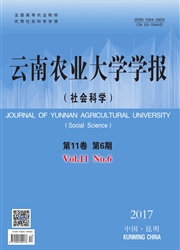

 中文摘要:
中文摘要:
从番茄病叶上分离到7株病原细菌菌株,采用柯赫氏法则确定为该病的病原。经培养性状观察、生理生化特性分析(Biolog系统)和16S r DNA序列分析,以及病原菌的寄主范围测定,确定该病原菌为疱斑黄单胞菌Xanthomonas campestris pv.vesicatoria(Dye)。依据室内平板抑菌试验初筛选结果,选取7株生防细菌进行温室复筛试验。温室试验中病原菌采用喷雾法接种,生防菌采用喷雾法和浸种法接种。研究测定7株生防细菌对番茄疮痂病的防治效果,同时比较两种接种方式对生防菌防治病害效果的影响。结果显示:生防菌菌株C3(解淀粉芽孢杆菌Bacillus amyloliquefaciens)、R^2-2(甲基营养型芽孢杆菌Bacillus methylotrophicus)、HY(抗生素溶杆菌Lysobacter antibioticus)对番茄疮痂病的防效较高,两种接种方法处理下对该病的防效始终高于65%;生防菌采用浸种法处理时,生防菌C3对番茄苍痂病的防效最好,为83.36%;生防菌采用喷雾法处理时,生防菌HY对番茄苍痂病的防效最好,为76.18%;两种不同的接种方法对菌株1-7影响最大,对M3的影响最小。
 英文摘要:
英文摘要:
Seven strains were isolated from diseased leaves from tomato. The same strains were re-isolated from inoculated leaves by the Koch ’s rule. The pathogen was identified as Xanthomonas campestris pv. vesicatoria( Dye) according to the characters of cultural colonies,morphological observation,biochemical and physiological identification( Biolog carbon source utilization analysis),16 S r DNA sequences analysis and further pathogenicity determination. Seven biocontrol bacteria were selected for the greenhouse experiment,based on the results of plate antibacterial test. The biocontrol bacteria control efficiency on tomato bacterial spot was determined by spray and seed soaking inoculation of biocontrol bacteria. Threestrains were screened out which had a significant control effect on tomato bacterial spot disease. The disease control efficiency of C3,R~2-2,HY( Bacillus amyloliquefaciens,Bacillus methylotrophicus,Lysobacter antibioticusstrain) strains were always higher than 65%. The results showed that strain C3 had a significant control effect of 83. 36%,when seed soaking inoculation of biocontrol bacteria,while the strain HY had a significant control effect of 76. 18%,when spray inoculation of biocontrol bacteria. Strains 1-7 and M3 were affected the maximum and minimum by two different inoculation methods,respectively.
 同期刊论文项目
同期刊论文项目
 同项目期刊论文
同项目期刊论文
 期刊信息
期刊信息
